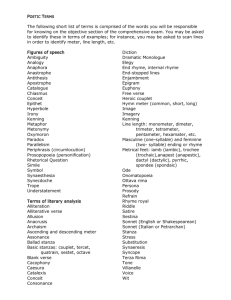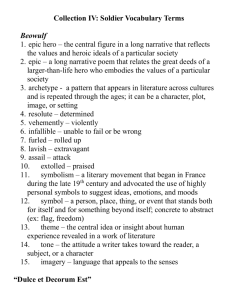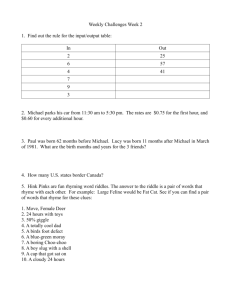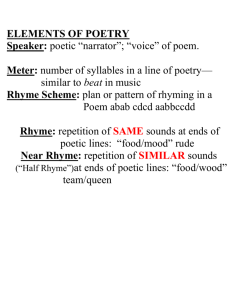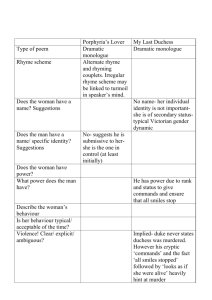Analysing Poetry - Year12VCE
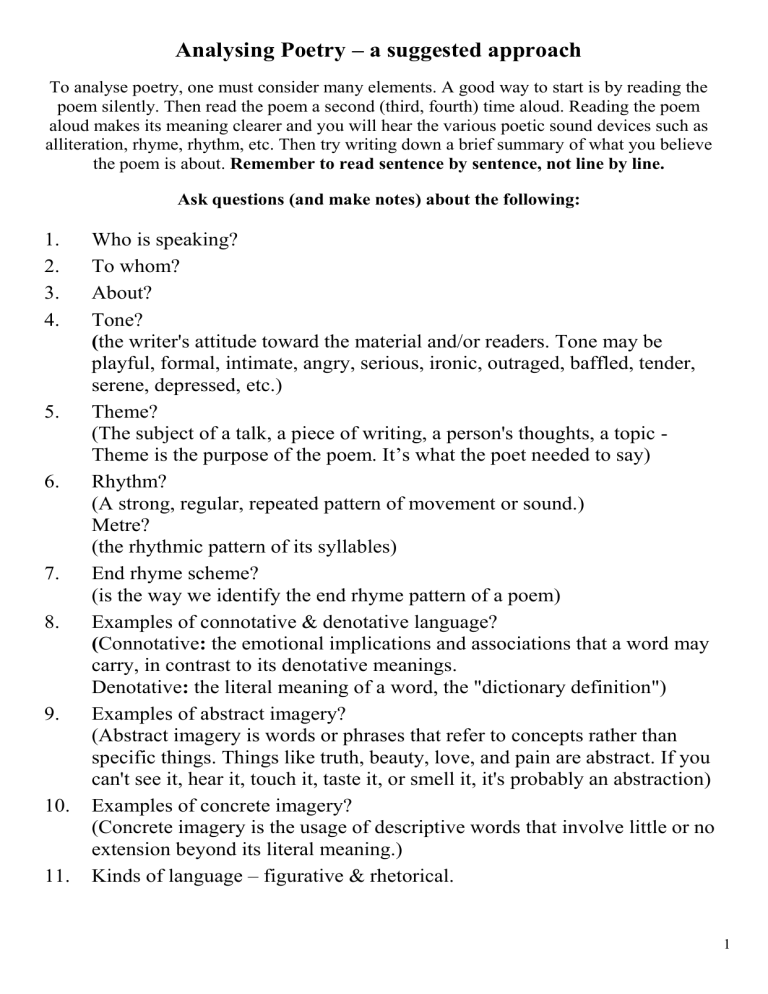
Analysing Poetry – a suggested approach
To analyse poetry, one must consider many elements. A good way to start is by reading the poem silently. Then read the poem a second (third, fourth) time aloud. Reading the poem aloud makes its meaning clearer and you will hear the various poetic sound devices such as alliteration, rhyme, rhythm, etc. Then try writing down a brief summary of what you believe the poem is about. Remember to read sentence by sentence, not line by line.
Ask questions (and make notes) about the following:
1. Who is speaking?
2. To whom?
3. About?
4. Tone?
( the writer's attitude toward the material and/or readers. Tone may be playful, formal, intimate, angry, serious, ironic, outraged, baffled, tender, serene, depressed, etc.)
5. Theme?
(The subject of a talk, a piece of writing, a person's thoughts, a topic -
Theme is the purpose of the poem. It’s what the poet needed to say)
6. Rhythm?
(A strong, regular, repeated pattern of movement or sound.)
Metre?
(the rhythmic pattern of its syllables)
7. End rhyme scheme?
(is the way we identify the end rhyme pattern of a poem)
8. Examples of connotative & denotative language?
( Connotative : the emotional implications and associations that a word may carry, in contrast to its denotative meanings.
Denotative : the literal meaning of a word, the "dictionary definition")
9. Examples of abstract imagery?
(Abstract imagery is words or phrases that refer to concepts rather than specific things. Things like truth, beauty, love, and pain are abstract. If you can't see it, hear it, touch it, taste it, or smell it, it's probably an abstraction)
10. Examples of concrete imagery?
(Concrete imagery is the usage of descriptive words that involve little or no extension beyond its literal meaning.)
11. Kinds of language – figurative & rhetorical.
1
12. Syntax?
(The arrangement of words and phrases to create well-formed sentences in a language.)
13. Caesura?
(any break, pause, or interruption)
14. Enjambment? (the running on of the thought from one line, couplet, or stanza to the next without a syntactical break)
The actual writing of the analysis is probably the easiest task because you have already identified everything that needs to be covered. You may wish to cover all the important items in your own order; however, the order listed above does work well. Most likely you will not be able to simply write a few lines for each device, rather you could group these devices together.
A suggested order of paragraphs may flow like this:
I. Dramatic Situation
A. Who is speaking?
B. To whom is that speaker speaking?
C. What is the situation?
D. What is the speaker's tone?
II. Theme
– (the purpose of the poem - what the poet needed to say)
Rhythm (a strong, regular, repeated pattern of movement or sound) and
III. Metre (the rhythmic pattern of its syllables)
End rhyme scheme (the way we identify the end rhyme pattern of a poem)
IV. Diction (word choice)
A. Connotation (suggested meaning of words)
B. Denotation (dictionary definition)
C. Abstract Imagery (can only be understood intellectually)
D. Concrete Imagery (words describing physical objects)
E.
Kinds of language:
Literary devices – Figurative ( uses "figures of speech" - a way of saying something other than the literal meaning of the words) and
Rhetorical (is also figurative but specifically uses language to convince or persuade) a. Alliteration?
(repetition of the same consonant sound beginning several words in sequence.)
2
b. c.
Assonance?
(repetition of the same vowel sound in words close to each other.)
Consonance?
(The repetition of consonants or of a consonant pattern, especially at the ends of words, as in blank and think or strong and string.) d. Metaphor (implied comparisons) e. Simile (comparison using 'like' or 'as') f. Personification (giving human characteristics to an inanimate object) g.
Metonymy (the use of an attribute or quality of an object to represent the object itself - the substitution of the name of an attribute or adjunct for that of the thing meant, for example
“suit” for business executive) h.
Synecdoche (substitutes a significant part of something for the thing itself - a figure of speech in which a part is made to represent the whole or vice versa, as in Cleveland won by six runs (meaning “Cleveland's baseball team”) i. Irony (opposite of what is meant) j. Hyperbole (exaggeration) k. Allusion (reference to something) l. Pun (play on words) m. n. o.
Paradox (contradictory)
Oxymoron (self contradictory term)
Litotes (form of understatement in which an affirmative is expressed by the negative of the contrary (as in “not a bad singer” or “not unhappy”)
V. Syntax (sentence structure)
A. Length
B. Transposed elements
C. "Unusual" sentences
3
D.
E.
Caesura (any break, pause, or interruption)
Enjambment (the running on of the thought from one line, couplet, or stanza to the next without a syntactical break)
VI. Conclusion
Remember, when you are analysing poetry you should use direct quotes wherever you can, you should vary your sentence structure, and all rules of grammar still apply.
4
Notes
7.
End Rhyme Scheme
End Rhyme Scheme is the way we identify the end rhyme pattern of a poem.
In order to understand it, all you have to do is look at the last words of each line.
Here are the rules:
1. Using the letters of the alphabet, assign the first letter (A), to the last word of the first line.
2. Look at the last word of the second line. If it rhymes with the last word in the line above, it gets the same letter, if it doesn't rhyme with the word above, it gets a new letter (the next one in the alphabet).
3. Continue the process described in #2 throughout the whole poem. Be sure to look at all the lines above to see if the last word of the line you are working on rhymes with any of the last words above.
Example:
Roses are red (red gets "A" as its designation)
Violets are blue (blue gets "B" because it does not rhyme with red)
End rhyme scheme is fun (fun gets "C" because it doesn't rhyme with red or blue)
And so are you! (you gets "B" because it rhymes with blue)
So, the end rhyme scheme is: A, B, C, B
Another example "A,B,A,B," indicates a four-line stanza in which the first and third lines rhyme, as do the second and fourth. Here is an example of this rhyme scheme from To Anthea, Who May Command Him Any Thing by Robert Herrick:
Bid me to weep, and I will weep
While I have eyes to see;
And having none, and yet I will keep
A heart to weep for thee.
A
B
A
B
A couplet is a pair of lines of metre in poetry. It usually consists of two lines that rhyme and have the same metre.
True wit is nature to advantage dress'd;
What oft was thought, but ne'er so well express'd.
— Alexander Pope
5
Whether or not we find what we are seeking is idle, biologically speaking.
— Edna St. Vincent Millay (at the end of a sonnet)
Sonnet - A Shakespearean, or English, sonnet consists of 14 lines, each line containing ten syllables and written in iambic pentameter, in which a pattern of an unstressed syllable followed by a stressed syllable is repeated five times. The rhyme scheme in a Shakespearean sonnet is a-b-a-b, c-d-c-d, e-f-e-f, g-g ; the last two lines are a rhyming couplet.
This example, Shakespeare's Sonnet 116 , illustrates the form (with some typical variances one may expect when reading an Elizabethan-age sonnet with modern eyes):
Let me not to the marriage of true minds (a)
Admit impediments, love is not love (b)*
Which alters when it alteration finds, (a)
Or bends with the remover to remove. (b)*
O no, it is an ever fixèd mark (c)**
That looks on tempests and is never shaken; (d)***
It is the star to every wand'ring bark, (c)**
Whose worth's unknown although his height be taken. (d)***
Love's not time's fool, though rosy lips and cheeks (e)
Within his bending sickle's compass come, (f)*
Love alters not with his brief hours and weeks, (e)
But bears it out even to the edge of doom: (f)*
If this be error and upon me proved, (g)*
I never writ, nor no man ever loved. (g)*
* PRONUNCIATION/RHYME: Note changes in pronunciation since composition.
** PRONUNCIATION/METER: "Fixed" pronounced as two-syllables, "fix-ed."
*** RHYME/METER: Feminine-rhyme-ending, eleven-syllable alternative.
The Prologue to Romeo and Juliet is also a sonnet:
PROLOGUE
Two households, both alike in dignity,
In fair Verona, where we lay our scene,
From ancient grudge break to new mutiny,
Where civil blood makes civil hands unclean.
From forth the fatal loins of these two foes
A pair of star-cross'd lovers take their life;
Whole misadventured piteous overthrows
Do with their death bury their parents' strife.
A
B
A
B
C
D
C
D
6
The fearful passage of their death-mark'd love,
And the continuance of their parents' rage,
E
F
Which, but their children's end, nought could remove, E
Is now the two hours' traffic of our stage; F
The which if you with patient ears attend, G
What here shall miss, our toil shall strive to mend. G
Example rhyme schemes
Alternating rhyme: abab cdcd efef ghgh ijij...
Chant royal: Five stanzas of "ababccddedE" followed by either "ddedE" or
"ccddedE". (The capital letters indicate a line repeated verbatim.)
Cinquain: "A,B,A,B,B"
Clerihew: "A,A,B,B"
Couplet: "A,A", but usually occurs as "A,A, B,B C,C D,D ..."
Enclosed rhyme (or enclosing rhyme): "ABBA"
"Fire and Ice" stanza: "ABAABCBCB" as used in Robert Frost's poem "Fire
and Ice"
Keatsian Ode: "ABABCDECDE" used in Keat's Ode on Indolence, Ode on a
Grecian Urn, Ode to a Nightingale and Ode to Psyche.
Limerick: "AABBA"
Monorhyme: "A,A,A,A,A...", an identical rhyme on every line, common in
Latin and Arabic
Ottava rima: "A,B,A,B,A,B,C,C"
Rhyme royal: "ABABBCC"
Scottish stanza: "AAABAB", as used by Robert Burns in works such as "To a
Mouse"
The Raven stanza: "ABCBBB", or "AA,B,CC,CB,B,B" when accounting for internal rhyme, as used by Edgar Allan Poe in "The Raven"
Rondelet: "AbAabbA"
Rubaiyat: "AABA"
Simple 4-line: "ABCB"
Sonnet
o o o
Petrarchan sonnet: "ABBA ABBA CDE CDE" or "ABBA ABBA CDC
DCD"
Shakespearean sonnet: "ABAB CDCD EFEF GG"
Spenserian sonnet: "ABAB BCBC CDCD EE" o Onegin stanzas: "aBaBccDDeFFeGG" with the lowercase letters representing feminine rhymes and the uppercase representing masculine rhymes, written in iambic tetrameter
Spenserian stanza: "ABABBCBCC"
Stopping by Woods on a Snowy Evening form: "AABA BBCB CCDC DDDD" a modified Ruba'i stanza used by Robert Frost for the eponymous poem.
Tanaga: traditional Tagalog tanaga is "AAAA"
7
Terza rima: "ABA BCB CDC ...", ending on "YZY Z", "YZY ZZ", or "YZY
ZYZ".
Triplet: "AAA", often repeating like the couplet.
The Road Not Taken
Taken .
stanza: "ABAAB" as used in Robert Frost's The Road Not
Villanelle: A1bA2 abA1 abA2 abA1 abA2 abA1A2, where A1 and A2 are lines repeated exactly which rhyme with the a lines.
Sestina: ABCDEF FAEBDC CFDABE ECBFAD DEACFB BDFECA , the seventh stanza is a tercet where line 1 has A in it but ends with D, line 2 has B in it but ends with E, line 3 has C in it but ends with F
8.
Denotation and Connotation
Denotation refers to the literal meaning of a word, the "dictionary definition."¨
For example, if you look up the word snake in a dictionary, you will discover that one of its denotative meanings is "any of numerous scaly, legless, sometimes venomous reptiles¡ having a long, tapering, cylindrical body and found in most tropical and temperate regions."
Connotation , on the other hand, refers to the associations that are connected to a certain word or the emotional suggestions related to that word. The connotative meanings of a word exist together with the denotative meanings.
The connotations for the word snake could include evil or danger.
9. & 10.
Abstract imagery is words or phrases that refer to concepts rather than specific things.
Things like truth, beauty, love, and pain are abstract. If you can't see it, hear it, touch it, taste it, or smell it, it's probably an abstraction. Poems with concrete imagery are much more interesting than poems that are filled with abstractions. Concrete imagery is the usage of descriptive words that involve little or no extension beyond its literal meaning.
11.
Kinds of language – figurative & rhetorical
Figurative language is a tool that an author employs (or uses) to help the reader visualize (or see) what is happening in a story or poem.
Figurative language uses "figures of speech" - a way of saying something other than the literal meaning of the words. For example, "All the world's a stage"
Rhetorical devices are a subset of figurative language but they use language specifically to convince or persuade.
8
Some Literary devices
– (you don’t need to know all of these but you would certainly be expected to know the most common ones)
Alliteration: repetition of the same sound beginning several words in sequence.
* Let us go forth to lead the land we love. J. F. Kennedy, Inaugural
Anaphora: the repetition of a word or phrase at the beginning of successive phrases, clauses or lines.
* We shall not flag or fail. We shall go on to the end. We shall fight in France, we shall fight on the seas and oceans, we shall fight with growing confidence and growing strength in the air, we shall defend our island, whatever the cost may be, we shall fight on the beaches, we shall fight on the landing grounds, we shall fight in the fields and in the streets, we shall fight in the hills. We shall never surrender. Churchill.
Antistrophe: repetition of the same word or phrase at the end of successive clauses.
* In 1931, ten years ago, Japan invaded Manchukuo -- without warning. In
1935, Italy invaded Ethiopia -- without warning. In 1938, Hitler occupied
Austria -- without warning. In 1939, Hitler invaded Czechoslovakia -- without warning. Later in 1939, Hitler invaded Poland -- without warning. And now
Japan has attacked Malaya and Thailand -- and the United States --without warning. Franklin D. Roosevelt
Assonance: repetition of the same sound in words close to each other.
* Thy kingdom come, thy will be done.
Cacophony: harsh joining of sounds.
* We want no parlay with you and your grisly gang who work your wicked will. W. Churchill
Euphemism: substitution of an agreeable or at least non-offensive expression for one whose plainer meaning might be harsh or unpleasant.
* When the final news came, there would be a ring at the front door -- a wife in this situation finds herself staring at the front door as if she no longer owns it or controls it--and outside the door would be a man... come to inform her that unfortunately something has happened out there, and her husband's body now lies incinerated in the swamps or the pines or the palmetto grass, "burned beyond recognition," which anyone who had been around an air base very long
(fortunately Jane had not) realized was quite an artful euphemism to describe a human body that now looked like an enormous fowl that has burned up in a stove, burned a blackish brown all over, greasy and blistered, fried, in a word, with not only the entire face and all the hair and the ears burned off, not to mention all the clothing, but also the hands and feet, with what remains of the arms and legs bent at the knees and elbows and burned into absolutely rigid angles, burned a greasy blackish brown like the bursting body itself, so that this husband, father, officer, gentleman, this ornamentum of some mother's eye, His Majesty the Baby of just twenty-odd years back, has been reduced to a charred hulk with wings and shanks sticking out of it. Tom Wolfe, The Right
Stuff
9
Foreshadowing
A soldier goes to war. He survives many brutal battles, just barely missing being killed several times. The soldier becomes obsessed with his “good luck”—why does he survive when so many others die? Every time the soldier has a brush with death, the author makes some subtle mention of a black motorcycle. Eventually, the soldier’s best friend is killed in a motorcycle crash the day after the war has ended.
The soldier himself comes home and not too long afterward, he dies by crashing his motorcycle.
In this example, the audience and character are equally ignorant about the outcome of the story. However, by using foreshadowing , the author begins to clue in his audience. The character’s fate is slowly revealed to the audience but not necessarily to the character himself.
Note that the ending to this story is doubly ironic—was the soldier “meant” to die in a motorcycle crash or did he bring it about through his own guilt about surviving while others perished? The theme of free will versus predetermination underlies this little story.
Hyperbole
I’m as hungry as a starving lion.
Hyperbole is a synonym for exaggeration . Clearly, the speaker is not really as hungry as a starving lion. A hyperbole is just a figure of speech we use to emphasize a point. The opposite device is understatement : I’m a little tired is a purposeful understatement if the speaker has been up for 48 hours.
Idioms and Clichés
That’ll cost you an arm and a leg.
Idioms are inherited quirks of language that native speakers understand without question but which cause nonnative speakers endless trouble. Only a native speaker knows that if something costs an arm and a leg that means it’s expensive, not that you actually need to lose your limbs to purchase it. Many overused idioms and symbols are clichés , and clichés themselves can be used ironically
Irony: expression of something which is contrary to the intended meaning; the words say one thing but mean another. [Said to a mean boss]: “ You’ve been so kind to me.”
A statement is ironic if it expresses something different from or opposite to the literal meaning of the words. This example is called verbal irony or sarcasm , which can be thought of as “heavy-handed irony”:
The overuse of antibiotics has led to the rise of resistant strains of many diseases .
A statement or situation can be ironic or paradoxical when the words accurately report events that seem to be contradictory but which have actually occurred, as in this example:
A soldier has returned from a war. He crashes his motorcycle and dies. His war experiences are told in flashback. Whenever he thinks about death, a motorcycle drives by .
10
A specific literary use of irony is called dramatic irony . In the example above, the audience knows that the soldier will die in a motorcycle crash. The soldier himself, of course, doesn’t know how he will die. (A flashback , by the way, is another literary device made popular by the movies. Flashbacks jump back in the story’s chronology to give background information. For example, the opening scene of the film Lord of the Rings: Return of the King shows Gollum before he found the ring.)
Metaphor: implied comparison achieved through a figurative use of words; the word is used not in its literal sense, but in one analogous to it.
* Life's but a walking shadow; a poor player,
That struts and frets his hour upon the stage. Shakespeare, Macbeth
Her eyes were pools of liquid light.
Again, her eyes are literally human eyes. Figuratively, they are being compared to pools of liquid light. However, the comparison is implied, not stated. This is an example of a metaphor . Unlike similes, metaphors compare unlike things without explicitly stating the comparison with “like” or “as.”
Motif
A motif is a symbol that is carried through an entire work of fiction. In the Lord of the Rings , the One Ring is a motif for the corrupting nature of power.
Onomatopoeia: use of words to imitate natural sounds; accommodation of sound to sense.
Oxymoron: apparent paradox achieved by the juxtaposition of words which seem to contradict one another.
* I must be cruel only to be kind. Shakespeare, Hamlet
Paradox: an assertion seemingly opposed to common sense, but that may yet have some truth in it.
* What a pity that youth must be wasted on the young. George Bernard Shaw
Personification: attribution of personality to an impersonal thing.
* England expects every man to do his duty. Lord Nelson
Personification
Her eyes followed me up the stairs.
Can eyes follow someone up the stairs? Not literally, but in this case an eye—which is not a person—is given a person’s abilities, namely, following someone else up the stairs. This is an example of personification .
Repetition
Duty does not trump honesty. Duty does not trump common sense. And duty, my friends, does not trump morality.
Repetition is the conscious and purposeful replication of words or phrases in order to make a point. In this example, it’s clear that the limits of duty are being sketched out.
The speaker is trying to show that duty is not the only or even the most important virtue.
Rhetorical Questions
Can poverty ever be eradicated?
11
Rhetorical questions are not meant to be answered. A rhetorical question is used to present what’s taken to be an unanswerable question, such as these questions:
Can a repeat offender ever be trusted not to commit another crime?
Can a person ever have too much love?
A rhetorical question can also be one in which the author’s answer is clearly intended to be “no” or “yes.” In these two examples, the author’s answer is clearly intended to be “no” (whether you agree with those answers or not).
Simile: an explicit comparison between two things using 'like' or 'as'.
* My love is as a fever, longing still
For that which longer nurseth the disease, Shakespeare, Sonnet CXLVII
Her eyes were like stars.
Her eyes are literally human eyes. Figuratively, they are being compared to stars, meaning, most likely, that they are bright and shiny and cause wonderment. This is an example of a simile . Similes use like and as to make explicit comparisons between unlike things, such as eyes and stars.
Sound Patterns
Her eyes were rippling pools of liquid light in which I splashed playfully.
This metaphor also uses sound patterns to underscore its meaning. Note that the letters l and p repeat: rippling pools of liquid light…splashed playfully. The author may have repeated “l” and “p” sounds to evoke the sound of water (like in the word splash itself) or simply to link together the words that make up the metaphor—or both.
Symbolism
Her eyes looked but did not see. All was dark .
Literally speaking, eyes either see (healthy eyes) or they don’t see (blind eyes). An eye that looks but does not see is blind in a figurative sense. Very often, vision and light are symbols for understanding and en light enment. In this example, the woman is most likely unaware of—or “in the dark”—about something. This is an example of symbolism .
12


